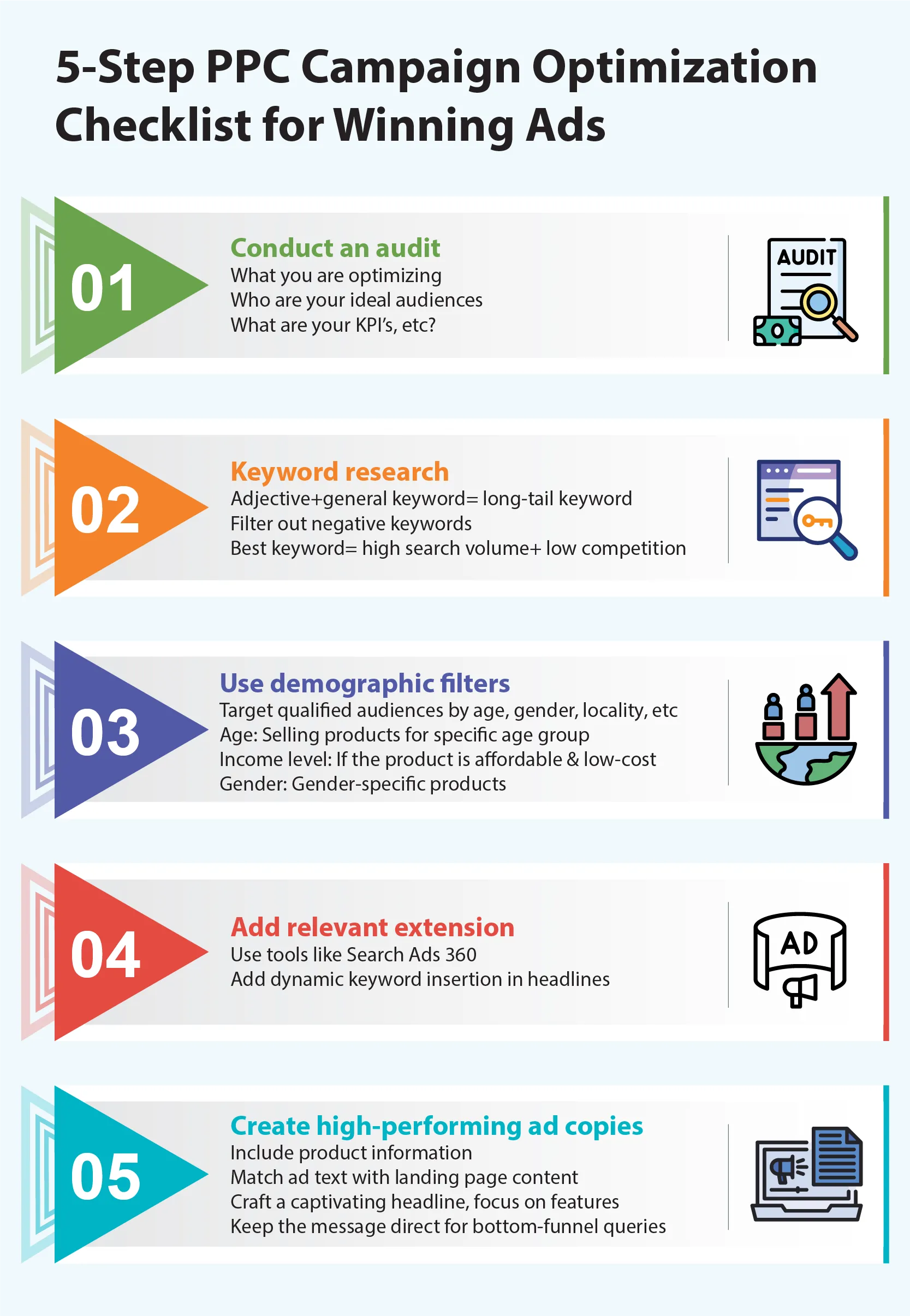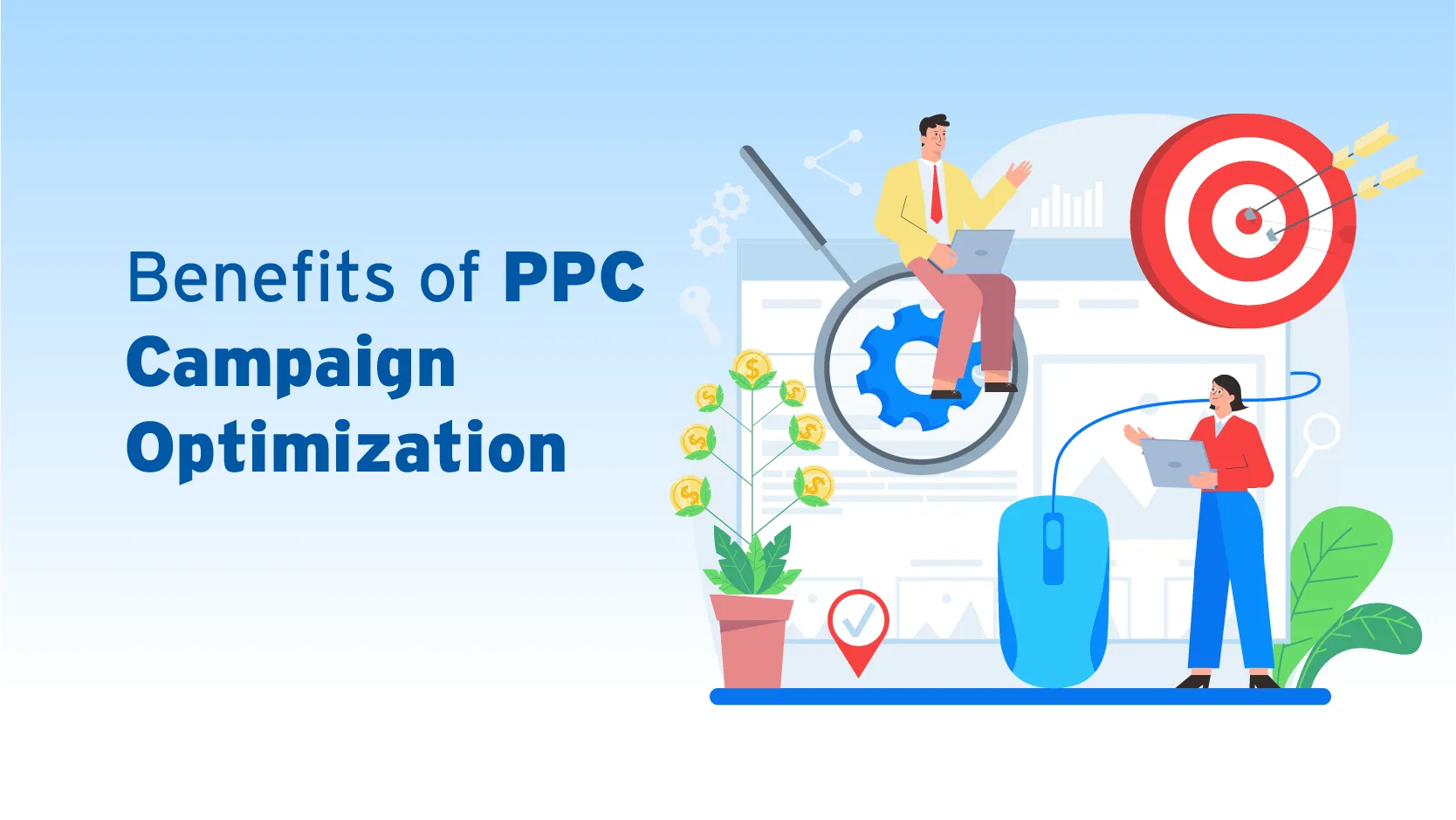Pay-per-click or PPC campaign optimization is an excellent way to grab those extra clicks. This works 2x than SEO strategies, which is why it is quite popular among marketers.
Search engine results display advertisements, which generate 45% of page clicks. This is why PPC is a great way to outrank competitors. But, to do that, you need to have an optimized strategy.
This blog post discusses how to optimize your PPC campaign so you can increase visibility, reach the target audience, and drive relevant traffic.
What Is PPC Campaign Optimization?
 PPC campaign optimization, or PPC optimization, is the practice of reviewing, analyzing, and editing campaigns to enhance the performance of paid search advertising. This involves improving campaign elements like:
PPC campaign optimization, or PPC optimization, is the practice of reviewing, analyzing, and editing campaigns to enhance the performance of paid search advertising. This involves improving campaign elements like:
- Changing ad copy
- Update landing copy
- Optimizing keywords
After launching a paid search campaign, you need to gather and evaluate its performance. Why prefer PPC?
Unlike SEO strategies, PPC optimization delivers faster results by appearing at the top of SERP. PPC traffic outperforms organic site traffic by 50%, sources state.
Companies spent $190.5 billion on search ads worldwide. Below are 5 ways to optimize PPC campaigns so you don’t waste a penny on bad ads.
5-Step PPC Campaign Optimization Checklist for Winning Ads

Now you know the what, and why, let’s dust off the “how” of the PPC campaign optimization.
1. Conduct an audit
Optimizing your PPC campaign won’t do you any good unless you know:
- What you are optimizing
- Who are your ideal audiences are
- What are your KPI, etc?
Create a basic KPI Google sheet or doc. Analyze the metrics like the past month vs. all time, year-over-year (YOY) performance, trends, etc.
This will allow you some context for your ad campaigns. Now set a baseline for ad performance.
2. Keyword research
Perform an extensive keyword research. Brainstorm and find out the most useful keyword for your business. Think of what will bring you the most clicks.
Figure out long-tail keywords rather than general keywords. This is because the former is more targeted and has less search volume, aka less targeted, more opportunity.
For example, the term “DevSecOps” has about 73,300 results. While the term “DevSecOps pipeline GitHub” has 6,420 results.
Use tools like Google Search, Helium 10 (for Amazon PPC), SE ranking, etc. Select keywords with low competition and high volume. Add adjectives related to your product or service to your general keyword.
Once you’re done with the above step, remove all negative keywords—meaning, any keywords burning money but not getting conversion.
Find keywords that are converting but you haven’t targeted yet. If it’s relevant, add it to your list. Be careful with Google’s account recommendations; they usually encourage spending more money.
3. Use demographic filters
Segment your audience based on their age, gender, income level, educational background, marital status, locality, etc.
This step allows you to create unique selling points for the right audience. See how different customer personas react to different ad types.
For example, provide free ebooks, and webinars, and analyze which format leads to high conversion and multiple that. For maximum ad reach, adjust bids based on device, day, time, etc.
A few pointers to consider before adjusting bids include:
- Identifying the best-selling days
- What time leads to the most conversion
- Are the users using desktop or mobile
- Where do I get quality traffic, and from which country?
- Which are the worst time & day which brings bad conversion
4. Add relevant extension
Your ad text and extensions can drive actions or lose audience. Ad extensions expand your presence on search results pages. This increase in visibility boosts traffic to your site.
Stand out with a great headline and call to action.
Boost CTR with dynamic keyword insertion in headlines. Save time with automation tools like Search Ads 360.
Some of the popular ad extensions for PPC campaign optimization include:
- Sitelink Extensions: Provide links to other relevant pages on your website.
- Callout Extensions: Gives additional information on what you’re offering, e.g., sales and free delivery.
- Structured Snippets: Allows you to highlight specific elements. For example, if you’re selling “handcrafted ceramic mugs,” include a list of colors.
- Location Extensions: Include your business address and telephone number in your ad copy.
- Message Extensions: Allow users to send an SMS to your business directly from the SERPs.
- Call Extensions: Allow users to dial a phone number provided in the ad copy.
5. Create high-performing ad copies
Before purchasing 85% of customers research the product online first. You can set up an amazing PPC campaign optimization strategy, but if your ad copies aren’t conversion-worthy, you’ll lose.
After all, landing page copies, make or break it. Here are a few tips to make sure your copies stand out.
- Include product information: This involves benefits, what it can solve, product features, size/colors available, measurement, etc.
- Great captivative headline. Include elements like odd numbers, dollar signs, benefits, challenges, and percentages to capture attention.
- Use hyper-local keywords to target specific geographic locations effectively.
- Ensure the ad text matches the landing page content to meet visitor’s expectations.
- Address potential objections in the headline to reduce perceived risk and encourage clicks.
- Keep the message direct, especially for bottom-funnel queries.
- Add effective call-to-action (CTA). Don’t include general CTAs like buy now, save later, etc. Use powerful CTAs like save a seat, claim your offer, or get started today.
A/B test the life out of your PPC campaigning (not literally). Testing doesn’t just mean ad copies, but also the color, font, text, image, etc.
Tip: Test just one factor to assess what element leads to more conversion. The more definite your testing factor, the better.
For example, WorkZone is a US-based software company providing project management solutions. It increased 34% more leads via A/B testing.
Google will randomly deliver your two adverts to distinct users when you set up an A/B test for your PPC ads. You’ll know after the testing period which advertisement had the most clicks and, consequently, which one you should employ in the future.
Additional Bonus Tips: Review assets and temporarily halt underperforming ones. Check impressions, clicks, etc.
If impressions are high but clicks are low, the ad isn’t relevant. If clicks are high but conversions are low, the ad and landing page don’t match. Pause the ad only if you have multiple assets available.
Also Read: Overview of Generative AI in Marketing: Future Proofing MarTech Stack
Benefits of PPC Campaign Optimization

Optimizing PPC (Pay-Per-Click) campaigns brings numerous advantages to enhance your advertising’s effectiveness. Here are the key benefits:
- Improved Ad Performance: Continuously optimizing ad text leads to more compelling and relevant ads, increasing clicks and driving traffic. Regular testing can significantly boost PPC performance.
- Increased Mobile Reach: Optimizing PPC campaigns for mobile is essential with a large global population using smartphones. Mobile-friendly landing pages and short-tail keywords help effectively engage mobile users.
- Reduced Cost per Acquisition (CPA): Optimized PPC campaigns result in higher conversion rates, reducing CPA.
- Better Campaign Monitoring: Regular PPC campaign monitoring helps track performance and make necessary adjustments. Analyzing metrics like click-through rates, conversion rates, and ROAS identifies success areas and opportunities for improvement.
- Targeted Keyword Expansion: Continuously adding relevant keywords expands your campaign’s reach, targeting a broader audience. Crafting tight keyword groups and optimizing ad text improves ad relevance and effectiveness.
- Improved Quality Score: Quality Score, rated by Google, assesses the quality and relevance of keywords, landing pages, and ads. Focusing on landing page quality and optimization enhances Quality Score and PPC performance.
- Better Return on Investment (ROI): Optimizing PPC campaigns increases ROI by improving ad performance, reducing costs, and boosting conversions. Optimization maximizes the effectiveness of your advertising budget.
Reaching the Right Audience
The above steps mentioned in this article will help you solidify your understanding of PPC campaign optimization. An important question to be asked is; how often should you optimize a PPC campaign?
Initially when it’s launched, monitor it daily to make sure there are no red flags and all issues are fixed then and there. Check if the clicks, impressions, reach, etc don’t flag out.
Don’t make changes until you have enough data to analyze, give it a month. In case the ad went horribly wrong, don’t scrap the campaigns, instead identify the culprit element. Optimize the element and test out the new strategy for a month. Repeat the cycle until you hit the right mix.


Comments are closed.